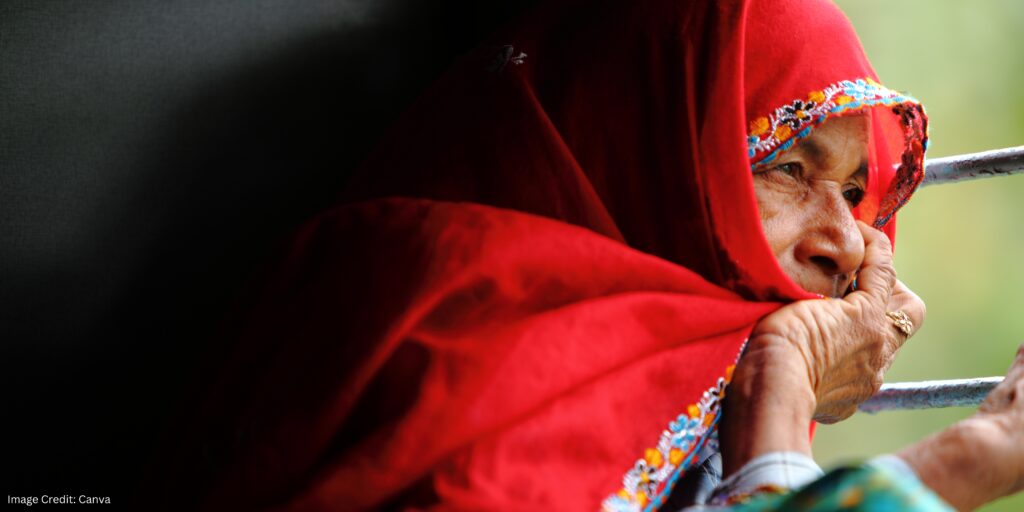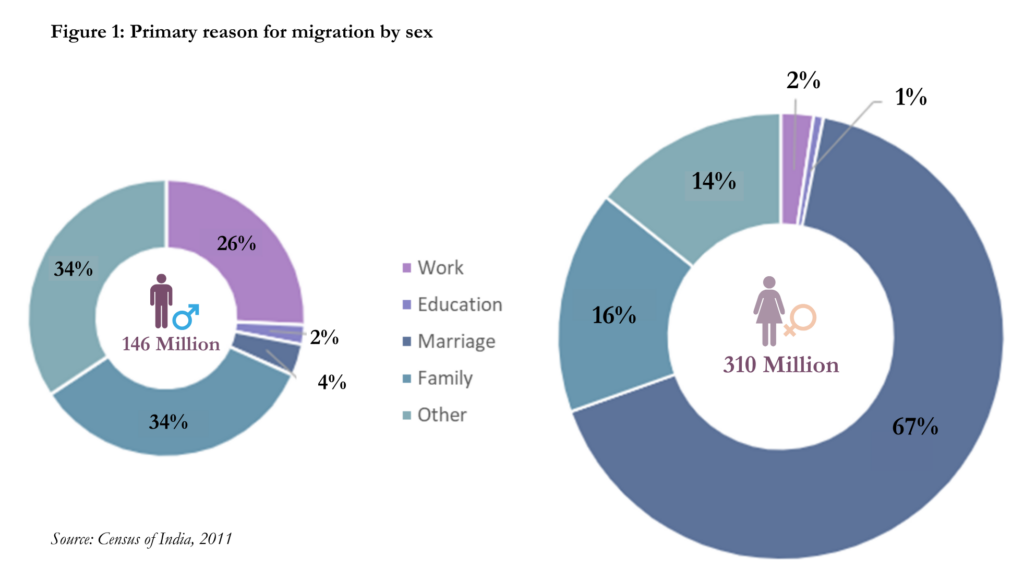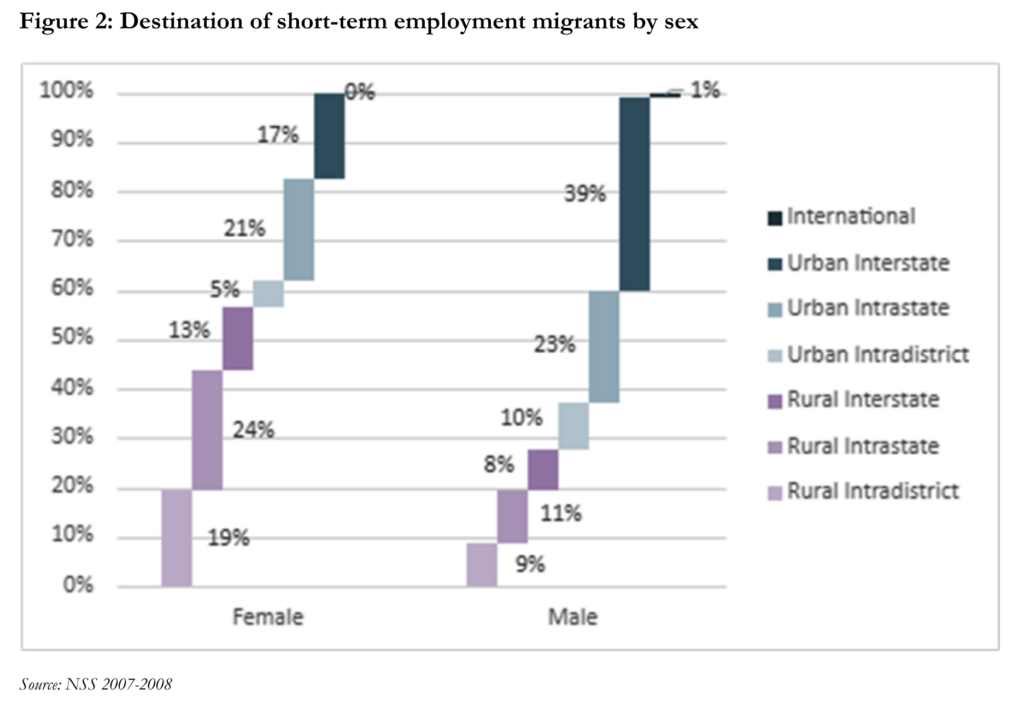
 In this issue of GenderTalk, we focus on the gender implications of internal migration in India. The drivers of women’s migration are complex and can include economic and educational opportunities, cultural practices surrounding family structure and marriage, desire for exploration of new built and social environments, a combination of these reasons, and many more.
In this issue of GenderTalk, we focus on the gender implications of internal migration in India. The drivers of women’s migration are complex and can include economic and educational opportunities, cultural practices surrounding family structure and marriage, desire for exploration of new built and social environments, a combination of these reasons, and many more.
In India, women comprise the vast majority of long-term migrants. According to the 2011 Census of India, of the nearly 456 million permanent migrants (defined as changing residence from one village/town to another village/town), 310 million (68%) are women; among women migrants, 206 million (66%) report marriage as the primary reason for migration (Census of India, 2011).
Figure 1 shows the primary reason for migration by sex. Among the 41 million migrants who reported permanently migrating for work as the primary reason in the 2011 Census, 15% are women. However, the dominant pattern of migration for work is temporary without a change in domicile. The 64th round of the National Sample Survey (NSS) conducted in 2007-2008 addressed this data gap by including items on short-term employment migration, defined as leaving the place of enumeration for more than 30 days but less than six months in the previous 365 days for or in search of employment. The gender distribution of short-term employment migration is similar to that of permanent employment migration – 15% of the estimated 13.6 million temporary employment migrants are women (National Sample Survey Organisation, 2010). Both of these national data sources, in addition to being exceedingly outdated, underestimate movement within the country as they overlook a critical group – circular migrants.
 Circular migrants repeatedly move between home and destination, often without the intention of permanent relocation (Zelinsky, 1971). Many of the industries that employ circular migrants operate for more than six months of the year, thus not meeting the definition of a short-term migrant by NSS, nor a permanent migrant as per Census. Recent estimates based on employment data suggest that 250 million people are repeatedly migrating between home and various destinations for jobs in sectors including textiles and garments, domestic work, and construction (Deshingkar, 2020). Women substantially participate in many of these areas of work. For example, of the estimated 23 million workers in the brick manufacturing industry (operational for eight to ten months of the year), close to half of migrant labourers are women due to male-female pair recruitment practices.
Circular migrants repeatedly move between home and destination, often without the intention of permanent relocation (Zelinsky, 1971). Many of the industries that employ circular migrants operate for more than six months of the year, thus not meeting the definition of a short-term migrant by NSS, nor a permanent migrant as per Census. Recent estimates based on employment data suggest that 250 million people are repeatedly migrating between home and various destinations for jobs in sectors including textiles and garments, domestic work, and construction (Deshingkar, 2020). Women substantially participate in many of these areas of work. For example, of the estimated 23 million workers in the brick manufacturing industry (operational for eight to ten months of the year), close to half of migrant labourers are women due to male-female pair recruitment practices.
While micro studies can provide useful data on female migration, those that have been conducted within India tend to focus on permanent, rural-to-urban migration – perhaps because of the ease of sampling this group, and/or because the policy narrative on migration is primarily from the urban lens with the objective of addressing urbanization. Critically, a key feature across multiple types of women’s migration is rural destination spaces. 72% of marriage migration among women is rural-to-rural; this is not surprising as India is still primarily rural.
 However, migration streams for education also vary by gender; the primary education migration stream for males is rural-to- urban, while for females it is rural-to-rural (Census of India, 2011). This is significant, as overall women and girls comprise 40% of long-term migration for education within the country. Migration streams are highly gendered among short-term employment migrants. Figure 2 shows women move to rural destinations closer to home for temporary work, compared to men who move farther away and to cities.
However, migration streams for education also vary by gender; the primary education migration stream for males is rural-to- urban, while for females it is rural-to-rural (Census of India, 2011). This is significant, as overall women and girls comprise 40% of long-term migration for education within the country. Migration streams are highly gendered among short-term employment migrants. Figure 2 shows women move to rural destinations closer to home for temporary work, compared to men who move farther away and to cities.
 Gendered migration destinations raise several important questions for which we need more nuanced and current data. For example, how do decision-making processes regarding destinations differ by gender? And do opportunities in rural and urban spaces differ for women and men?
Gendered migration destinations raise several important questions for which we need more nuanced and current data. For example, how do decision-making processes regarding destinations differ by gender? And do opportunities in rural and urban spaces differ for women and men?
With respect to social implications, to what extent does marriage enable mobility? Conversely, how does unaccompanied migration of younger women for education or work influence later life decisions such as marriage and family structures?
For work opportunities where women circularly migrate with their husbands and children, such as construction, how does nuclearization of the family unit during migration affect women’s decision-making power and control over income? In our study of circular migrant families working and living on rural brick kilns in Bihar, we found that traditional gender roles persist during migration with respect to control over income, market purchases, mobility outside the home environment of the brick kiln, and child care and feeding (Roshania et al., 2023).
Better national level detailed data on women’s migration are necessary for informing programs and policies, not only for women who migrate, but also for those who remain behind in source areas with migrant spouses.
This issue brings together a wide-ranging view of women’s voluntary internal migration in India. We recognize the criticality of gender in forced migration and its relevance in the Indian context with respect to human trafficking and displacement due to conflict and natural disaster; we also note the importance of gender in international migration from India. While the current issue does not explore these topics, we hope to engage on them in the future.
References:
Census of India. (2011). Table D-5: Migrants by place of last residence, age, sex, reason for migration and duration of residence.
Deshingkar, P. (2020). Faceless and dispossessed: India’s circular migrants in the times of COVID-19. DownToEarth. https://www.downtoearth.org.in/blog/economy/faceless-and- dispossessed-india-s-circular-migrants-in-the-times-of-covid-19- 71782
National Sample Survey Organisation. (2010). Migration in India, 2007-08: NSS 64th Round, July 2007-June 2008. Report No. 533.
Roshania, R. P., Webb-Girard, A., Das, A., Giri, R., Mala, G. S., Srikantiah, S., Young, M. F., Mahapatra, T., & Ramakrishnan, U. (2023). Food Environments, Food Security, and Household Food Availability of Circular Migrant Families: A Mixed-Methods Study Among Brick Kiln Laborers in Bihar, India. Food and nutrition bulletin, 03795721231152057.
Zelinsky, W. (1971). The hypothesis of the mobility transition. Geographical review, 219-249.
_______________________________________
Reshma Roshania is an Associate Fellow at NCAER. Her research interests include nutrition, food policy, migration, and gender. She has a PhD in Nutrition and Health Sciences from Emory University, where she studied food environments and nutrition among circular migrant families in Bihar.